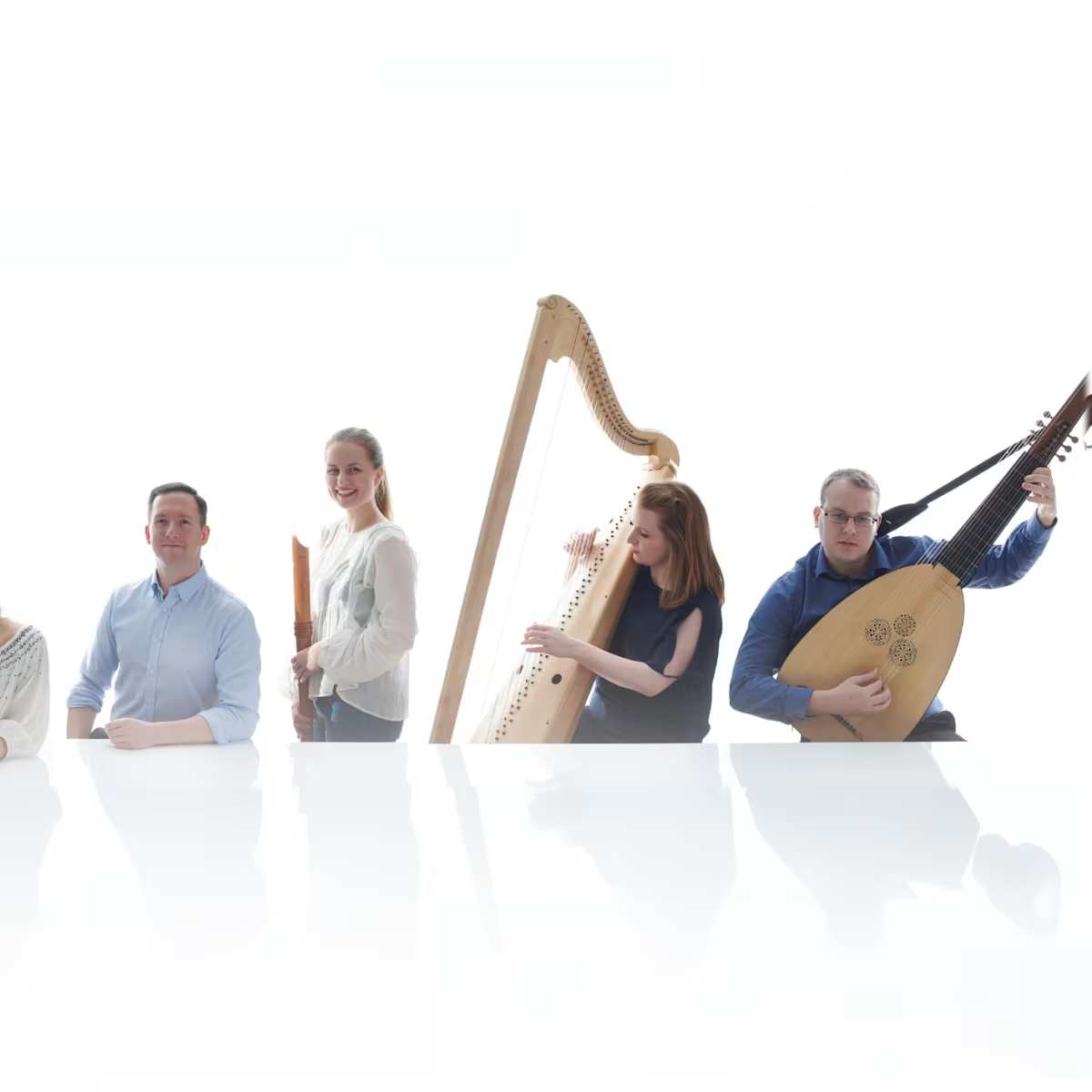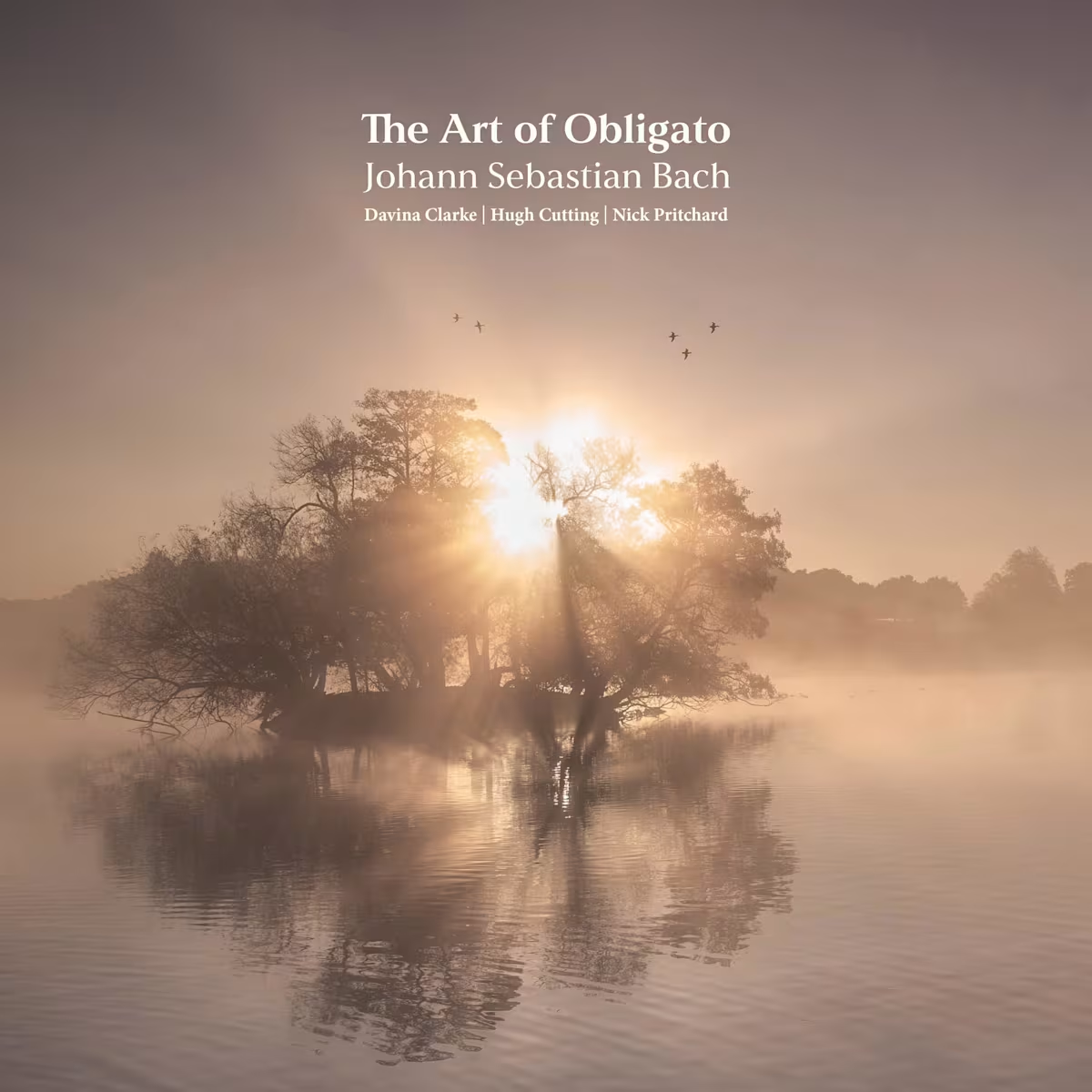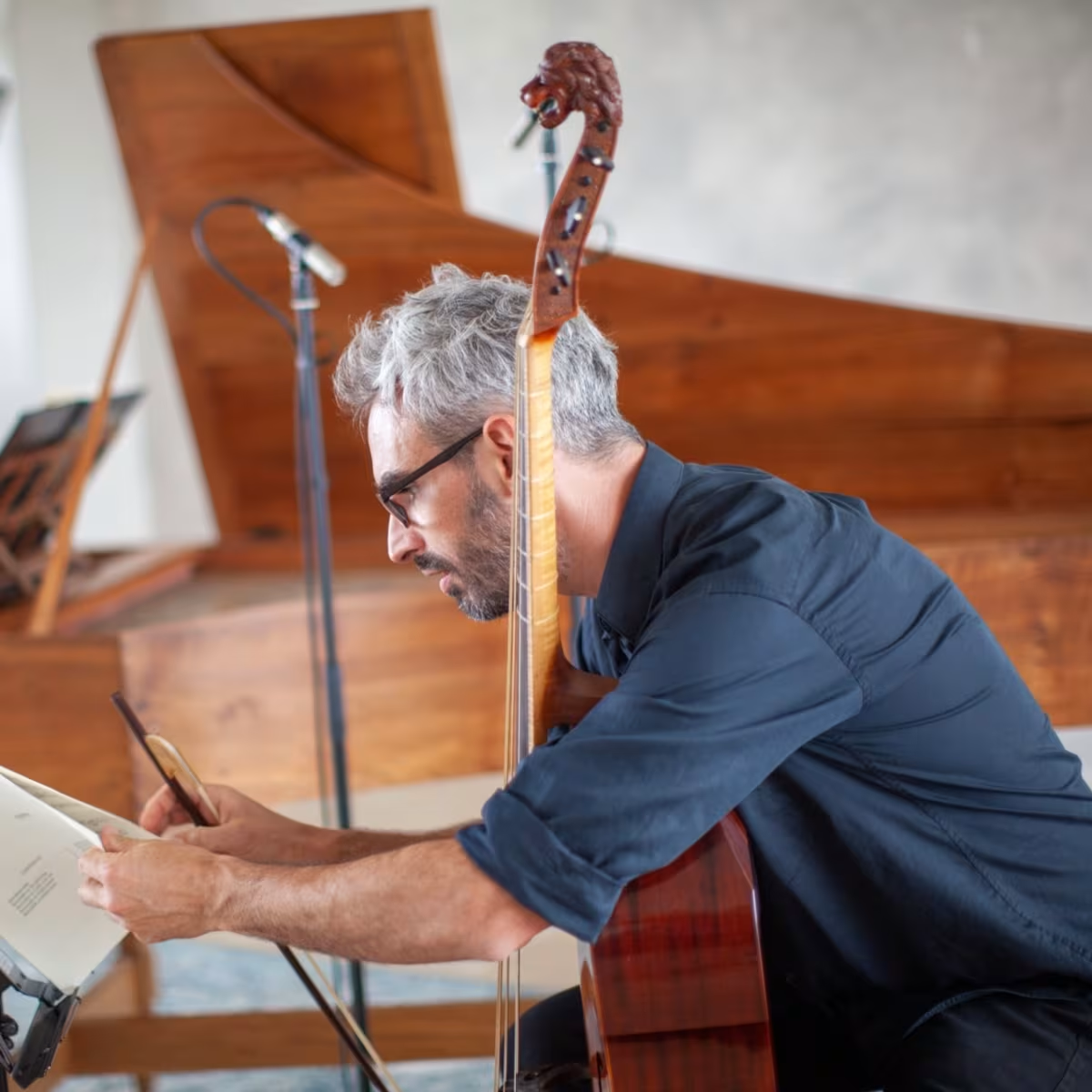Essay
The Battle of the Organs
A look behind the scenes
Share this

“Celestial Music did the Gods Inspire”, now available as a full-length concert film, brings to life the extraordinary musical story of the Battle of the Organs, performed in the very building where the action took place, London’s historic Temple Church. Thomas Allery and Mary-Jannet Leith from Ensemble Hesperi take us behind the scenes.
The Story
In the early 1680s, after the Great Fire of London, Temple Church commissioned none other than Christopher Wren to refurbish its interiors. After the renovations were completed, a dispute arose between Middle and Inner Temples as to which of two leading organ builders of the day, Bernhard Smith and Renatus Harris, should furnish the church with a new instrument. The Benchers of Middle Temple had a strong preference for Smith’s organ, but those of Inner Temple favoured the challenger, Harris. In a matter of months, the battle commenced: two men erected two organs at opposite ends of the church, and vied with each other, showcasing their instruments on alternate Sundays. Each organ maker invited the most celebrated players of the day to showcase their craftsmanship, who in turn astonished the crowds gathered for the ‘trials’ with their virtuosic performances. As the societies of the Inner and Middle Temples struggled to choose a winner, a fierce rivalry developed, and each builder strived to outdo the other, rumours of sabotage never far away.
As we dramatize the tale today, it might seem amusing that the indecision of two organisations on the appointment of an organ builder led to such a hotly-contested musical battle. We often hear tales of grandeur, extravagance, and success and failure in the opera houses of late seventeenth-century England, but music in the life of London’s great churches evidently was just as vibrant and controversial! Indeed, the purchase of a new organ, by the best builder in town, was an unmissable opportunity for the Temple Church to show that it had the best musical taste in the City of London.
Finally, after many years in which both builders became frustrated with the expense and effort of maintaining their instruments in the church, Smith’s organ triumphed. It was described by the benchers of Middle Temple in June 1685:
“[Smith’s organ] is incomparably the best for the Sweetness and fullness of sound. Especially in that Part of it which is of frequent and ordinary use, and also that the Extraordinary stops therein, do far exceed those of the other organ, and their Masters are also clearly Satisfied in their judgement that the said organ made by Mr Smith is not only preferable for the loudness & Elegancy of sound, but also more ornamental, substantial, durable in all respects fit for the use of the church than the said other organ by Mr Harris, which is too low and too weak for the said Church.”
The Programme
During the ‘trials’ of the two organs, the winning instrument was demonstrated by two leading musicians of late seventeenth-century London, John Blow and Henry Purcell. To celebrate their success, we decided to programme several verse anthems by each composer, as this amazing body of repertoire is rarely performed, and largely unrecorded. This may be partly because the genre requires very specific instrumental and vocal forces, of at least a string band and continuo, which simply aren’t present even in London’s greatest churches on a Sunday morning. These settings are also often too long for modern liturgical use, and so are therefore rarely tackled by church choirs today for this reason.
Added to this, the vocal writing is often rhythmically angular and quirky, and therefore difficult to perform; there are moments of virtuosity, but also long stretches where the writing is subtle in its expression, and singers are required to declaim long passages of scripture in a way which can be understood by the audience. Finally, this is the sort of music which needs a fairly intimate setting to come alive: if you can’t hear the text and see the expression and interplay between the singers and players, you lose something of the magic, and so it requires quite a bit of work to produce a satisfying musical result. We certainly found this incredible music worth the effort!

Alongside our musical performances, we also featured readings from the eighteenth-century historian John Hawkins and the archival records of Middle Temple and Inner Temple, which told the story of the Battle of the Organs from start to finish. These fascinating sources offer a window into this unfamiliar historical world, and really bring the fierce competition between the organ builders to life for modern-day audiences. Here’s a brilliant example from historian John Hawkins:
“The contention between these eminent artists was carried on with such spirit, not to say violence, as perhaps never happened before, or since, on a similar occasion. The partisans for each candidate, in the fury of their zeal, proceeded to the most mischievous and unwarrantable acts of hostilities; and that in the night, preceding the last trial of the reed-stops, the friends of Harris cut the bellows of Smith’s organ in such a manner, than when the time came for playing upon it, no wind could be conveyed into the wind-chest.”
— John Hawkins, General History of the Science and Practice of Music

The Composers
Sadly, John Blow’s illustrious career is largely forgotten today, but he, together with Purcell, monopolised the high offices at the choral establishments of the Chapel Royal, St Paul’s Cathedral and Westminster Abbey, in the last quarter of the seventeenth century. Ten years Purcell’s elder, Blow was awarded a doctorate in music at the age of twenty-eight and was in great demand as a teacher. The vast majority of Blow’s output was sacred, as demanded by his church roles, and he composed over 100 anthems, many at a very young age. Henry Purcell, Blow’s student, became the organist of Westminster Abbey in 1679, and in 1682, he also took up a post at the Chapel Royal. During this period, Purcell appears to have severed his better-known connection with London’s theatres, instead composing largely sacred music, including two anthems for the coronation of King James II.
The Music
“Celestial Music did the Gods Inspire” showcases four fine English verse anthems, all of which feature sections for small groups of soloists alongside parts for full choir and gorgeous instrumental symphonies.
The opening work, Blow’s The Lord is King, and hath put on glorious apparel, is set to the text of Psalm 93, and features alto, tenor, and bass verses, preceded by a joyful instrumental symphony. The next anthem, Lord, who shall dwell in thy tabernacle, is the result of a period of compositional experimentation for Blow in around 1680, in which he started to incorporate wind instruments, including recorders, into his accompanying band of instruments. Amongst these rarely heard gems, we perform an anthem still regularly sung by cathedral choirs today, Purcell’s Rejoice in the Lord always, or the “Bell Anthem”, in which the peals of bells are beautifully depicted through the weaving of the opening instrumental lines.
The final anthem, Blow’s And I heard a great voice, is an exceptionally powerful setting of a text from the book of Revelation. The verse sections are scored for alto, tenor and two bass parts, the latter portraying the ‘thunderings’ of the mighty voice of God. The work, and the concert, ends with a cascade of alleluias, celebrating God’s eternal reign in heaven.
While sacred vocal music is at the heart of our programme, the title piece of our project, Purcell’s Ode, Celestial music did the Gods Inspire, is an extraordinary yet rarely performed secular work. It was commissioned by the headteacher of a London school, Mr Maidwell, at whose premises the piece was first performed on 5th August 1689. Scored for SATB, strings, and recorders, this piece is full of harmonic originality and elaborate word-painting, and the libretto, by an anonymous ‘pupil’, champions music as the balm to the cares and evils of this world.
To create a variety of focus and atmosphere, the four core members of Ensemble Hesperi also perform two trio sonatas by Blow and Purcell alone, moving to a different part of the space to use the harpsichord instead of the chamber organ. Purcell’s stormy sonata in B minor is one of Ten Sonatas in Four Parts, a collection published posthumously by Purcell’s widow, Frances, who arranged for it to be printed and sold by Henry Playford of Temple Change. Blow’s only trio sonata in A major drips with lyricism and operatic flair, reflecting his skill in writing for London’s many entertainment spaces. Quirky and full of invention, both of these instrumental sonatas showcase a now-unfamiliar style reflecting the cosmopolitan musical tastes of late seventeenth-century England.

Performing music in the historical spaces our composers knew so well is a special experience for the performers and audience alike. It was particularly meaningful to perform the music of Blow and Purcell in the very building where they themselves had “battled” over three hundred years before. The Temple Church was also a perfect venue for the performance of our sacred verse anthems, which originally sought to convey sacred meaning through scriptural texts to a church congregation. While these were written for large churches or even cathedrals, they would often have been heard within the more intimate spaces within these buildings. The atmosphere and acoustic of the Temple Church, with the musical action taking place against the magnificent backdrop of Wren’s Ten Commandments and Lord’s Prayer, was suitable in every way for the music at the heart of our programme.
Although ‘directed’ from the organ by Thomas Allery, our performance was unconducted in the modern sense, as we were determined to imbue this larger project with our usual chamber music spirit. In the verse anthem genre, individual voices are often required to perform in small consorts of between one to four voices, and we were lucky to be able to engage wonderful singers, who were skilled at finding the balance between the approach of declaiming text as a soloist and working within an ensemble. Within this spirit of collaborative music-making, this music is incredibly intimate, and the words and the shapes of the vocal lines inspire each and every member of the instrumental group. We hope that you enjoy the result!
Supported by a grant from Continuo Foundation, and filmed by sound engineer and videographer Tom Mungall and his team, the concert is available to view on Continuo Connect. To download the full programme, texts and programme notes, as well as a list of performers and sponsors, head to Ensemble Hesperi's website.
Share this
Keep reading

Lux Musicae London: Iberian Imagination
Lux Musicae London's Secrets of Andalusia explores the fusion of Islamic, Jewish, and European traditions in post-1492 Spain, tracing roots of flamenco.

The Art of Obligato
In The Art of Obligato, Davina Clarke explores Bach’s cantata arias with violin, joined by Nick Pritchard, Hugh Cutting, and a skilled continuo ensemble.

In conversation: Jan Zahourek
Continuo Connect meets freelance double bass, viola da gamba and violone player Jan Zahourek who enjoys a variety of collaborations.

